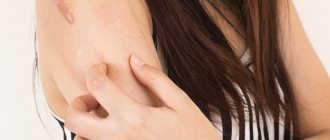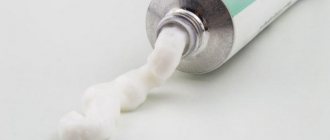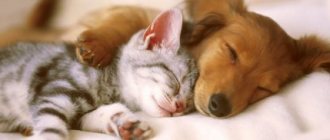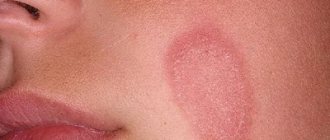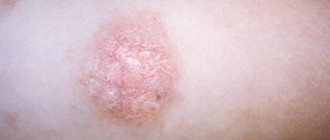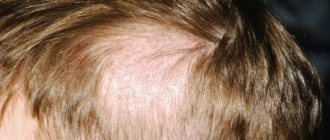General description of the disease
Ringworm is a skin disease that is characterized by a rash (scaly patches, small itchy nodules, or inflammatory patches of papules). The term “lichen” combines a number of dermatoses caused by various types of microbes, viruses or microscopic fungi. The disease progresses unpredictably: it appears suddenly, then subsides, and can slowly develop over months or years.
Causes of the disease
Path of transmission of the disease: zooanthropophilic pathogens are transmitted from an infected domestic animal to humans; anthropophilic pathogens are transmitted from sick person to person; geophilic pathogens (most often fungi) enter human skin through contact with the ground.
Prerequisites for the occurrence of lichen
If a person is already infected with pathogens, then lichen may appear during a period when the body’s immune level is reduced due to severe stress, hypothermia, allergic reactions to medications, or a long-term illness. Often, the development of lichen is facilitated by a genetic predisposition.
Types of lichen and their signs
- 1 Zhiber's lichen or “pink lichen” (pathogen: herpes virus type seven) begins to develop from a single (maternal) spot, its core after some time turns yellow and begins to peel off. Over the course of several days, small spots appear on the chest, back, hips and shoulders, which may itch slightly.
- 2 Pityriasis versicolor or “multi-colored” lichen (pathogen: fungus Pityrosporum ovale) is characterized by the appearance of scaly, clearly defined spots of light, white, dark, red-brown color. Often, this type of lichen occurs as a result of hormonal imbalance, which is provoked by diabetes, pregnancy, Cushing's syndrome, cancer problems, tuberculosis, and diseases of the endocrine system. The pathogen is transmitted through contact with a sick person or through everyday items.
- 3 Trichophytosis or ringworm (pathogen: anthropophilic trichophyton, which parasitizes inside the hair) is different in that it affects the head, smooth skin and nail plates. They develop pink flaky spots covered with white-gray scales, as well as areas of thinning hair or broken off remains. Often the disease is accompanied by itching or worsening general condition.
- 4 Shingles (caused by the Herpes zoster virus, which attacks nerve cells) is characterized by fever, severe headache, malaise, skin inflammation and pain in the area of the sensory nerve. In the chest area, the skin is covered with bubbles with transparent contents, which dry out and peel off over time, after which intoxication and pain subside, but signs of neuralgia persist for several months. This type of lichen can develop against the background of chronic stress, overwork, decreased immunity, bone marrow transplantation, cancer, or taking medications.
- 5 Lichen planus develops on the skin, mucous membrane or nails and is manifested by many flat red nodules with a “pressed-in” core that itch unbearably. Typically, rashes appear on the elbows, lower abdomen, armpits, lower back and forearms.
Varieties of lichen
The definition of “lichen” unites a group of skin diseases in which rashes accompanied by itching occur. Ringworm is caused by one or another pathogen. The nature and localization of the skin rash depends on its type. Highlight:
- pink lichen of Zhiber - has an infectious-allergic nature;
- herpes zoster - occurs when herpes type 3 is activated;
- pityriasis versicolor, or pityriasis versicolor - affects the stratum corneum of the epidermis;
- ringworm - has a fungal nature, affects smooth skin and scalp;
- red flat - occurs when immunity decreases.
Diagnosis of lichen
Diagnosis of all types of lichen includes:
- listening to patient complaints;
- anamnesis analysis;
- inspection of rashes to determine their color, size, shape, location, etc.
Further, the dermatologist’s actions depend on the preliminary diagnosis he made.
Diagnosis of pityriasis rosea
To diagnose pityriasis rosea in a child or adult, in addition to a medical examination, during which the final diagnosis is usually determined, the following is additionally carried out:
- microscopy of scales to exclude syphilis;
- serodiagnosis of syphilis.
A biochemical and general blood test is also taken, and a general urine test is given.
Diagnosis of herpes zoster
Usually, a doctor can accurately determine whether a patient has pityriasis rosea during an examination. But in some situations additional research methods are required:
- detection of viral DNA by polymerase chain reaction in the contents of vesicles and in the blood;
- determining the presence of antibodies to the pathogen;
- identification of the pathogen virus genome in cells/tissue sections using in situ hybridization.
Diagnosis of pityriasis versicolor (lichen)
Diagnosis of versicolor versicolor pumps in:
- Balzer test (iodine test). The affected areas of the skin are treated with iodine and immediately wiped with alcohol. Pityriasis versicolor always turns brown;
- examination under a Wood's lamp (lichen looks like a brown or yellow glow);
- microscopic examination of scales (allows one to identify hyphae (curved short filaments of mycelium), oval and round spores).
Diagnosis of ringworm
To determine ringworm, the following are carried out:
- examination of lesions using a Wood's lamp (lichen becomes green);
- microscopic examination;
- sowing the discharge on various nutrient media (to determine the sensitivity of the pathogen to antibiotics);
- biochemical and general blood tests, urine analysis.
Diagnosis of lichen planus
To diagnose lichen planus in an adult/child, a small affected area of skin is taken for histological examination. The patient is also prescribed a general urine and blood test and biochemistry.
General dietary recommendations
In many cases, skin rashes appear on a person if the balance in the diet is imbalanced - the body does not receive enough vitamins, minerals and there is too little liquid in the daily menu. The immune system weakens, and along with it, the barrier properties of the skin decrease.
The skin becomes defenseless during pathogen attacks. It is easier for a virus or fungus to enter the body and begin to multiply. The diet for various types of lichen is aimed at eliminating these gaps:
- Drink enough clean water.
- Include foods that are good for the skin, gastrointestinal tract and immune system in your menu.
- Form new eating habits by eating simple but nutritious meals without an abundance of flavor enhancers, dyes and sweeteners.
List of approved products
A diet for lichen involves including foods rich in dietary fiber in the daily menu. For skin diseases, their ability to absorb under-oxidized metabolic products in the digestive tract is especially valued. The body's defenses and skin health directly depend on the normal functioning of the intestines, and any failure in this finely coordinated system is immediately reflected in skin rashes.
Use antioxidant products to neutralize the effects of negative environmental factors.
Therefore, an individual diet for lichen should be formed with an increase in the amount of bran (can be purchased separately as an additive to the diet), prunes, apples and limiting all semi-finished products with a long shelf life.
Vegetables and fruits in season, whole grain cereals, lean meat and fish, natural dairy products include the entire line of essential vitamins and microelements, but for lichen, vitamins E and P are especially important, stimulating:
- skin regeneration and cleansing of age spots and scars;
- cell nutrition and respiration;
- strengthening the vascular system;
- skin barrier for UV protection;
- the body's defenses in the fight against viruses and fungi.
For lichen, the following foods are taken as the basis of the diet:
- green salad, dill, parsley, lettuce, onion shoots, fresh mint;
- vegetables in season with the exception of the nightshade group (tomatoes, sweet peppers);
- rosehip, rowan, sea buckthorn (add dry berries to tea), black currant, cherry;
- almonds, pistachios, pine and walnuts (no more than half a handful per day), sunflower seeds;
- whole grain bread and bakery products without yeast and with added bran;
- oatmeal, barley, semolina, rice, corn and buckwheat porridge with water;
- cottage cheese, sour cream, natural yogurt, in the morning - a small amount of butter or cream;
- natural drinks, such as non-alcoholic kvass, fresh compotes, jelly, weak green tea, kefir, fermented baked milk, ayran, still mineral water, and in between meals - just clean water.
What to exclude
During the period of exacerbation of deprivation, the diet should not contain products that include preservatives and flavors. You should refrain from salty and fried foods, marinated, too fatty and rich in spices. Exclude from the diet:
- chocolate and cocoa in the form of a drink;
- any citrus fruits;
- chicken eggs;
- cakes, pastries containing nuts, chocolate, especially products with cream;
- butter and other animal fats are kept to a minimum;
- mustard and horseradish;
- spices, including ground black and red pepper;
- nightshade vegetables: potatoes, eggplants, tomatoes, capsicums, nightshade;
- any types of alcoholic beverages;
- rich broths;
- legumes;
- smoked meats
You should limit your consumption of strong tea and coffee.
You should not drink a lot of coffee, tea or cocoa. Avoid baked goods based on cooking and animal fats, cakes and pastries with cream, chocolate and legumes.
You need more clean water in the amount recommended for your gender, age and weight. This will help normalize metabolism and cleanse the body of waste and toxins.
Menu (Power Mode)
From the list of allowed foods, you can create a varied menu, alternating different protein and cereal dishes throughout the week. Remember, vegetables or fruits should be included at every meal. You should enrich your dishes with bran, vegetable oils, seeds and nuts (if they are not contraindicated for you). Use cold-pressed vegetable oils in salads. Fruits can be used for snacks. If fermented milk products are indicated for you, then include them in your diet every day.
| Breakfast |
|
| Lunch |
|
| Dinner |
|
| Afternoon snack |
|
| Dinner |
|
| For the night |
|
Features of diet for different dermatoses
If you maintain a balanced diet of carbohydrates, fats, proteins, vitamins and microelements, the exacerbation of lichen will pass faster.
The body will have sufficient resources to combat external unfavorable factors and directly against viruses and fungal infections. Since the causative agent is different for each specific type of lichen, the diet has a number of features.
For fungal lichens
The diet should include simple dishes with one or two ingredients, without a lot of oils and hot spices. Products from the permitted list are best consumed fresh, boiled, steamed or baked. The main taboos for fungal lichen (pityriasis versicolor, ringworm) are flour, sweets, and alcohol.
During periods of exacerbation of the disease, they are generally excluded from the diet, and during periods of remission they are consumed in minimal quantities. The diet involves moderate consumption of vegetable and animal fats. It is recommended to take fish oil.
For herpes zoster
The diet for shingles in adults is aimed at strengthening the immune system. Shingles, by the fact of its appearance, indicates that the body’s defenses are unable to keep the virus in a “dormant” state.
The daily menu includes vegetable soups, fresh salads, lean meat, fish and vitamin drinks: weak tea with the addition of fresh blackcurrant leaves, raspberries, and rose hips.
For lichen planus and lichen rosea of Zhiber
The diet for pityriasis rosea should be hypoallergenic and based on the consumption of dairy products, vegetables and fruits, with the exception of those included in the list of prohibited ones.
It is better to exclude bananas and peaches from fruits, buckwheat from cereals, as well as legumes (beans and peas). Oatmeal and barley porridge with water and the addition of vegetable oils in a minimal amount are allowed.
On the black list: confectionery, baked goods with cream, citrus fruits, chicken eggs and all types of preserved foods (temporary ban on salty and sour foods).
Food is consumed fresh; dishes should not be too cold or hot. You should eat warm food.
Reviews and results
There are no significant dietary restrictions and many foods and processing methods are available. The food is healthy and nutritious. The only drawback is the limitation of salt and simple carbohydrates. Some people find it difficult to tolerate the lack of chocolate, coffee, sweets and cakes in their diet, but such restrictions for a month are quite doable.
- “... It seems to me that nutrition does not help much with lichen ruber, but during an exacerbation I exclude everything spicy, salty, smoked and sweets - I noticed that they increase the itching. At least while treatment is being carried out (which is 3-4 weeks), you need to stick to the diet. The liver and pancreas are normal, so the rash is not related to this. It seems to me that exacerbation occurs after stress”;
- “... Against the background of diabetes mellitus, pityriasis versicolor periodically appears in one place, which the doctor associates with impaired immunity. I already stick to the diet, but during this period I also exclude salt and spicy pickled vegetables. True, I still have problems with bowel movements and the doctor told me to definitely fight it. I recommended taking bran at night, 2 large spoons with kefir. The bran really helped, since due to my underlying illness I can’t eat a lot of beets, prunes and dried apricots”;
- “...I have pityriasis rosea. I noticed that exacerbation begins after eating chocolate, citrus fruits, eggs and seafood. Of course, I exclude these foods, plus I don’t add enough salt to everything, I don’t fry them, and I exclude smoked foods. Usually, if the exacerbation is not severe, after 1.5 months the disease disappears, even without the use of medications. Therefore, I came to the conclusion that I need to do a deload for the liver and intestines once a quarter: eat cereals, vegetables, a minimum of meat, fruits and sour milk. Even at this time I add bran to all dishes. No coffee, candy, sweets or buns. I think that this way I can keep the disease in check. The truth shouldn’t be nervous yet.”
Dietary recipes
Nutrition for herpes zoster, fungal lichen, pink, red and pityriasis versicolor should be easily digestible. Soups are prepared in weak meat (boil beef or poultry and change the water after boiling) or vegetable broth with the addition of cereals. This dish, combined with whole grain porridge and salad, is an excellent lunch option.
As a dessert or fresh salads (in the absence of allergies) it is allowed to supplement with a small amount of honey. It is better to refrain from spicy dressings in the form of mustard, ground pepper, and vinegar. It is preferable to steam meat and fish or bake them in foil with vegetables.
Baked fish with vegetables
Ingredients:
- 500 g flounder fillet (or cod, carp, carp);
- 2-3 sprigs of parsley and dill;
- young carrots;
- medium-sized onion;
- a quarter teaspoon of a mixture of dry ground black pepper, thyme and oregano;
- vegetable oil for lubrication;
- salt to taste.
Cooking method:
- Line a medium-sized baking dish with foil.
- Divide the fish fillet into the required number of servings and place on foil squares.
- To each serving of fish, add finely chopped onions and carrots cut into thin long strips (can be chopped on a special grater).
- Sprinkle the fish with vegetable oil (olive or sunflower), salt and sprinkle with spices.
- Roll the foil squares with fish into envelopes or tubes and pinch the edges tightly.
- Bake the fish in a well-heated oven for 35-40 minutes at a temperature of 180-200 degrees. Check readiness and, if necessary, leave in the oven for another 5-7 minutes.
- Serve baked salmon with vegetables with natural yogurt, fresh parsley and dill and cucumber.
Diet soup with meatballs
Ingredients:
- 100 g minced beef;
- 50 g ground turkey;
- medium-sized onion;
- half a bunch of parsley;
- salt and ground black pepper to taste;
- a quarter of one piece each of carrots and white turnips;
- 3-4 green onions.
Cooking method:
- Mix the two types of minced meat thoroughly.
- Peel the onion and divide into two halves. Chop the first very finely and add to the minced meat, cut the second into thin rings.
- Cut the carrots and turnips into small cubes and cook over moderate heat.
- After boiling, add onion rings, salt and pepper the soup.
- Chop the parsley very finely and add half to the minced meat.
- Form small balls from the minced meat. Add to the soup and continue to simmer over low heat.
- Add the remaining parsley and finely chopped green onions to the finished soup.
- Serve with freshly prepared croutons.
Features of treatment
Fluconazole is a drug for the treatment of candidiasis.
Treatment of esophageal candidiasis in most cases is carried out with the use of medications.
For this purpose, antifungal medications are used. To ensure the full functioning of the immune system, it is necessary to use immunostimulants.
To treat esophageal candidiasis, it is necessary to use three groups of drugs. Therapy is carried out using polyene antibiotics. These medications are widely used to eliminate genital candidiasis.
In most cases, treatment of intestinal candidiasis is carried out with the use of Natamycin and Nitstatin. During the treatment of the disease, it is necessary to take into account the weak effectiveness of these drugs.
Azole antibiotics in the form of Albaconazole, Fluconazole, Introconazole, and Ketoconazole can be used to treat the pathological condition. The third group of drugs for the treatment of esophageal candidiasis includes echinocandins. In most cases, treatment of the pathological condition is carried out with Micafungin, Capsofungin, Anidufalfungin.
In order to activate immune processes, patients are prescribed a granulocyte concentrate to the affected area. This procedure is performed using an endoscope. Despite the huge number of medications that are used to treat esophageal candidiasis, it is very difficult to correct the affected organ.
This is explained by the fact that many medications are characterized by insufficient effectiveness. Other medications have undesirable effects that are difficult to treat. In addition, many Candida fungi are resistant to antifungal medications.


